Abstract
The hyperbicarbonatemia of chronic respiratory acidosis is maintained by enhanced bicarbonate reabsorption in the proximal tubule. To investigate the cellular mechanisms involved in this adaptation, cell and luminal pH were measured microfluorometrically using (2",7')-bis(carboxyethyl)-(5,6)-carboxyfluorescein in isolated, microperfused S2 proximal convoluted tubules from control and acidotic rabbits. Chronic respiratory acidosis was induced by exposure to 10% CO2 for 52-56 h. Tubules from acidotic rabbits had a significantly lower luminal pH after 1-mm perfused length (7.03 +/- 0.09 vs. 7.26 +/- 0.06 in controls, perfusion rate = 10 nl/min). Chronic respiratory acidosis increased the initial rate of cell acidification (dpHi/dt) in response to luminal sodium removal by 63% and in response to lowering luminal pH (7.4-6.8) by 69%. Chronic respiratory acidosis also increased dpHi/dt in response to peritubular sodium removal by 63% and in response to lowering peritubular pH by 73%. In conclusion, chronic respiratory acidosis induces a parallel increase in the rates of the luminal Na/H antiporter and the basolateral Na/(HCO3)3 cotransporter. Therefore, the enhanced proximal tubule reabsorption of bicarbonate in chronic respiratory acidosis may be, at least in part, mediated by a parallel adaptation of these transporters.
Full text
PDF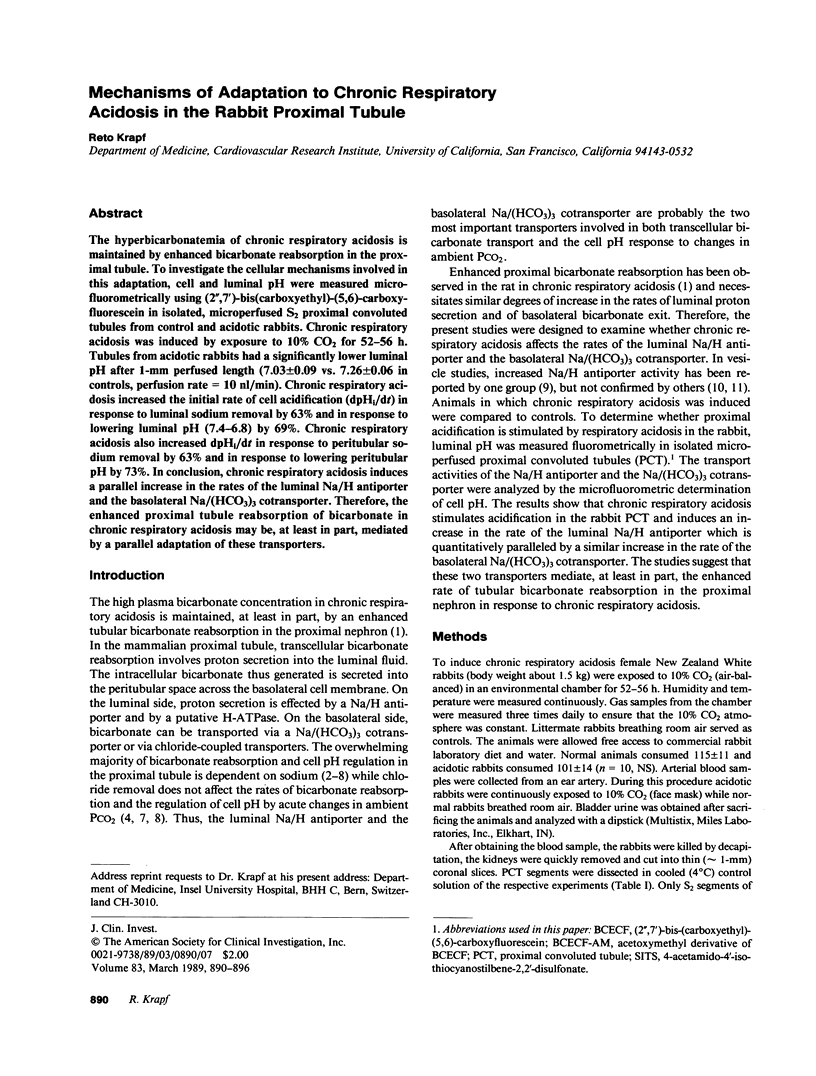
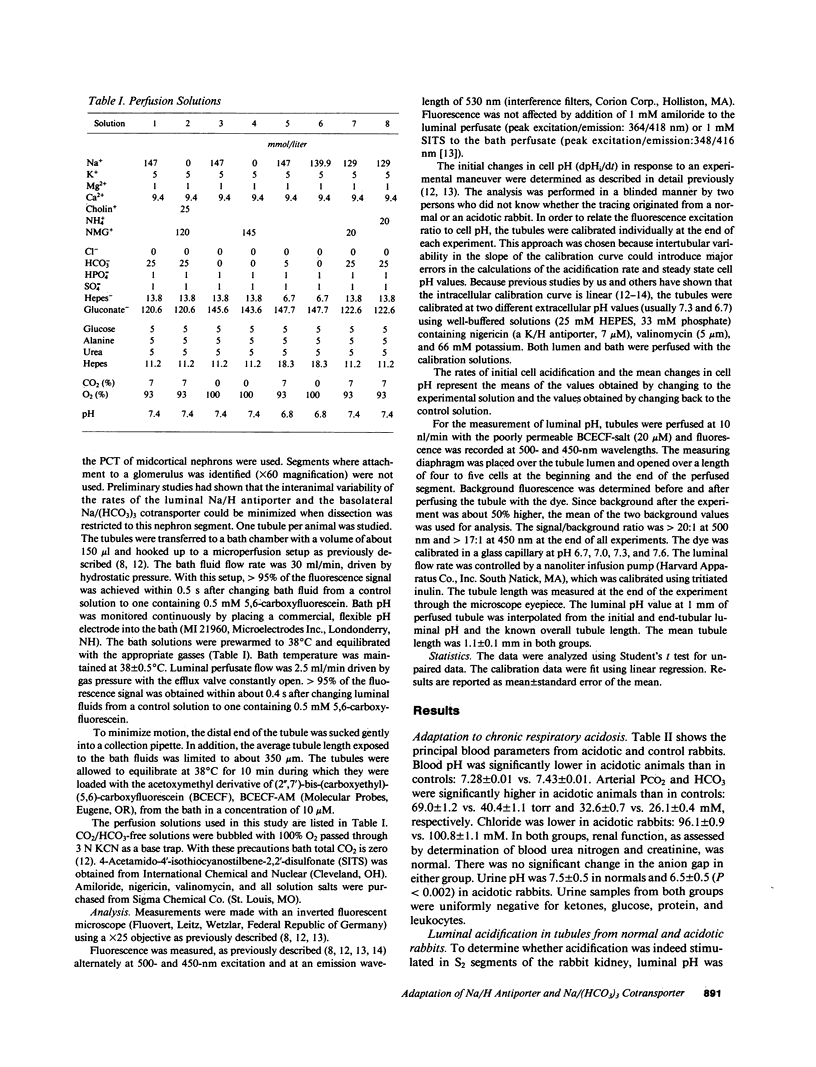
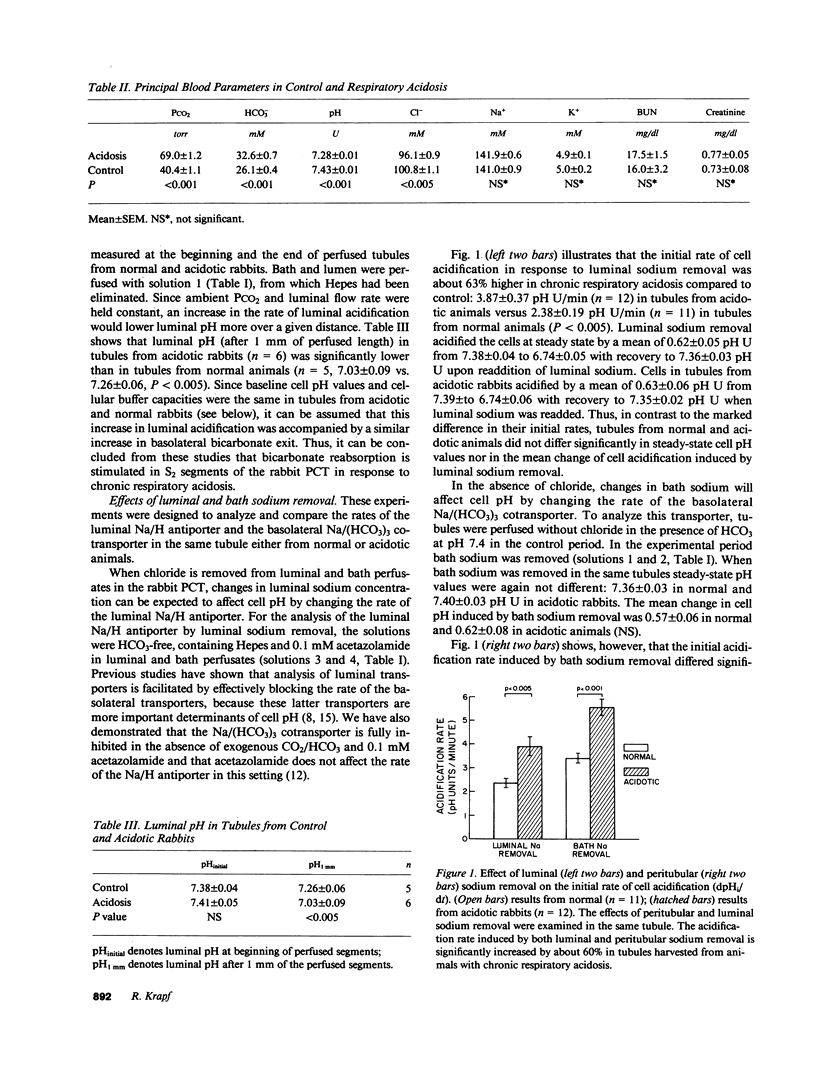
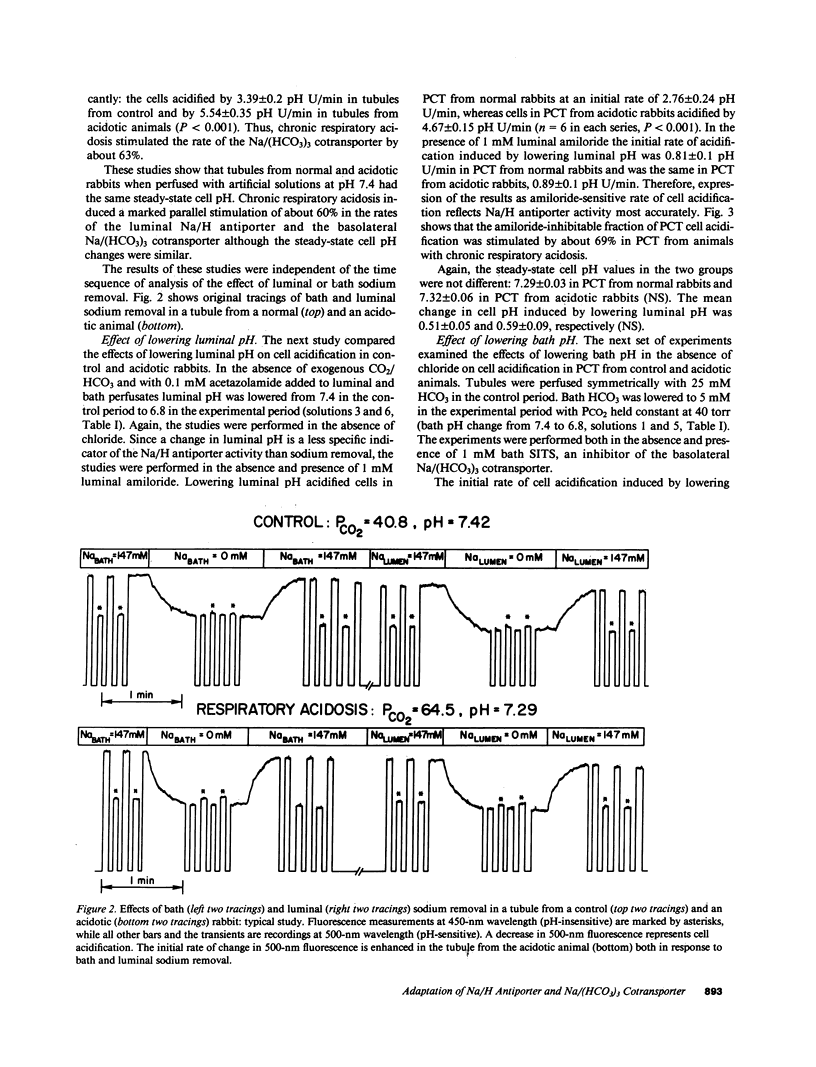
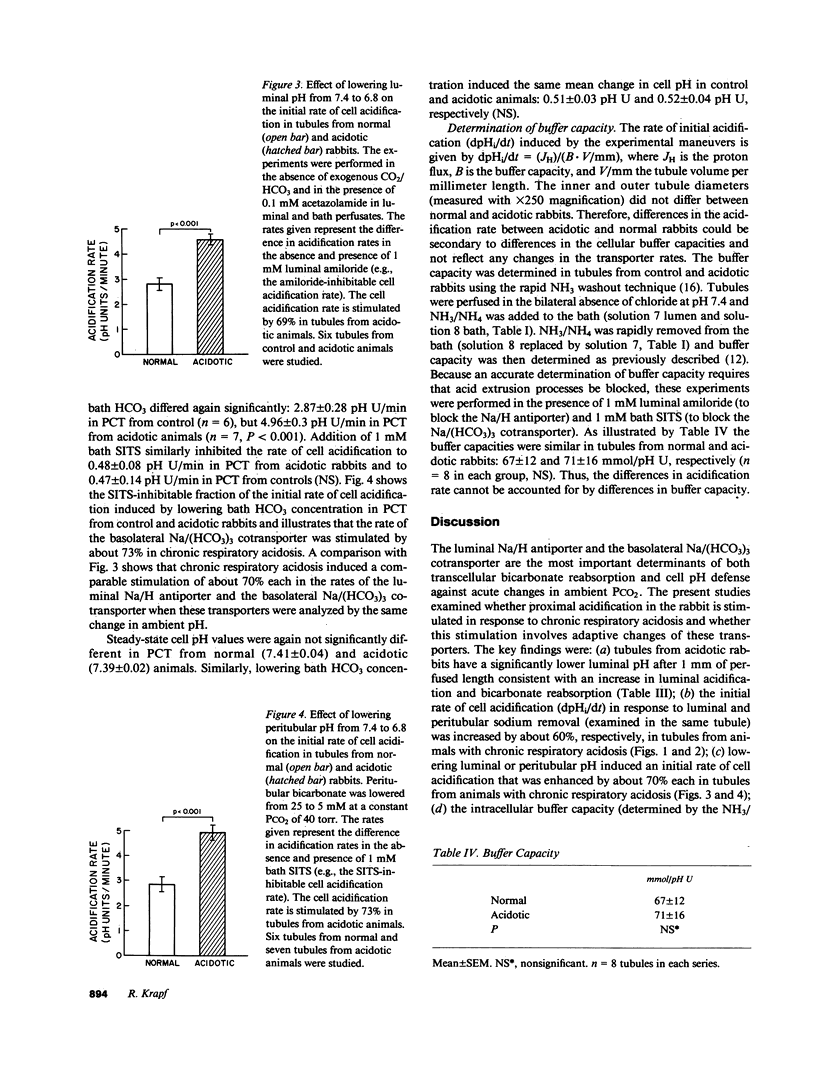
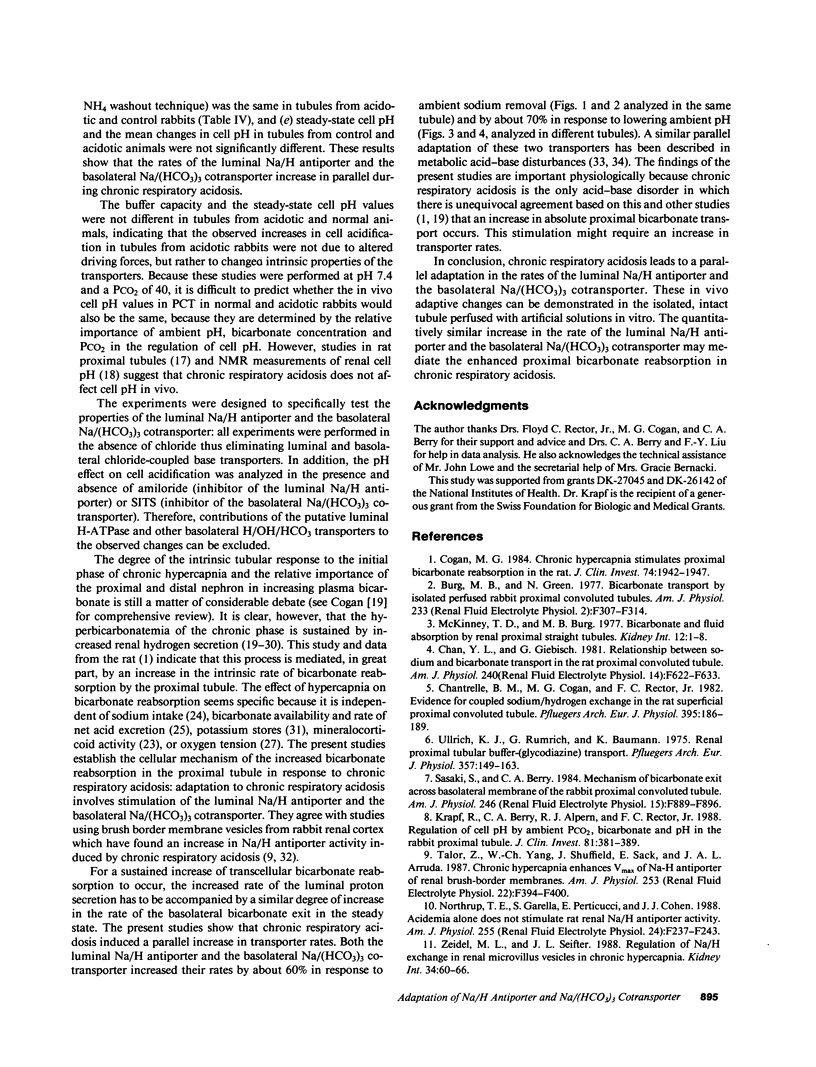
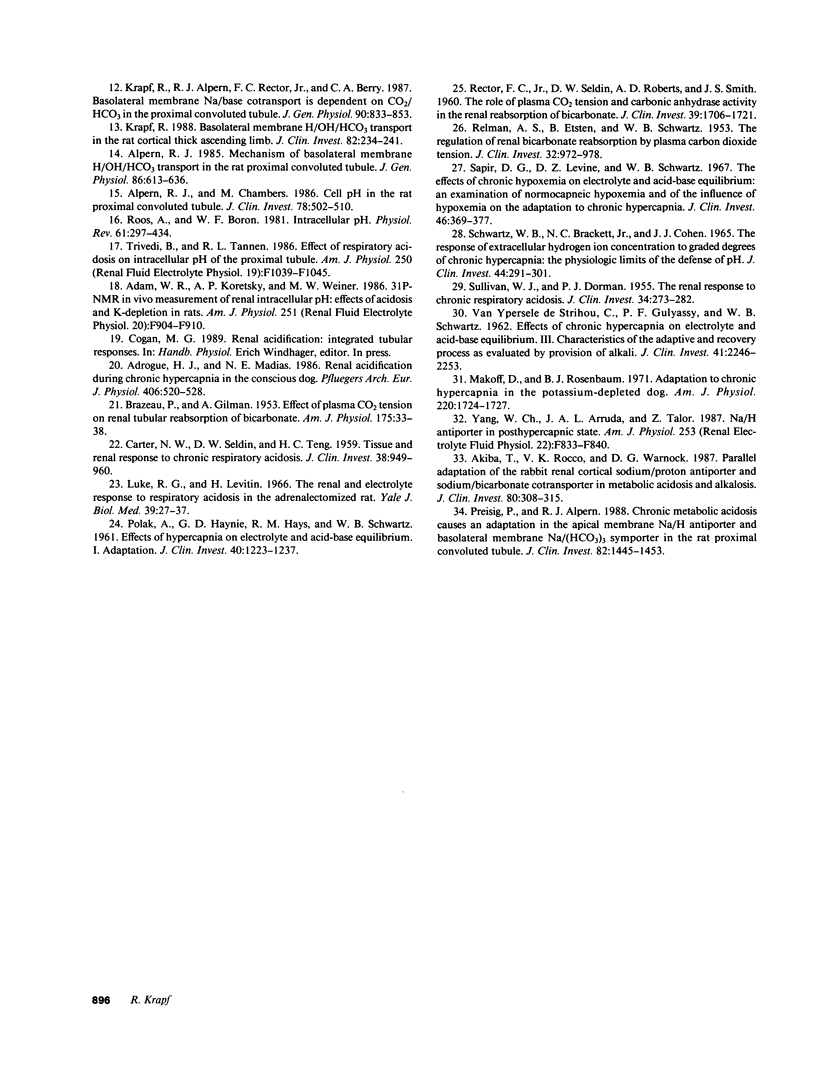
Selected References
These references are in PubMed. This may not be the complete list of references from this article.
- Adam W. R., Koretsky A. P., Weiner M. W. 31P-NMR in vivo measurement of renal intracellular pH: effects of acidosis and K+ depletion in rats. Am J Physiol. 1986 Nov;251(5 Pt 2):F904–F910. doi: 10.1152/ajprenal.1986.251.5.F904. [DOI] [PubMed] [Google Scholar]
- Adrogué H. J., Madias N. E. Renal acidification during chronic hypercapnia in the conscious dog. Pflugers Arch. 1986 May;406(5):520–528. doi: 10.1007/BF00583376. [DOI] [PubMed] [Google Scholar]
- Akiba T., Rocco V. K., Warnock D. G. Parallel adaptation of the rabbit renal cortical sodium/proton antiporter and sodium/bicarbonate cotransporter in metabolic acidosis and alkalosis. J Clin Invest. 1987 Aug;80(2):308–315. doi: 10.1172/JCI113074. [DOI] [PMC free article] [PubMed] [Google Scholar]
- Alpern R. J., Chambers M. Cell pH in the rat proximal convoluted tubule. Regulation by luminal and peritubular pH and sodium concentration. J Clin Invest. 1986 Aug;78(2):502–510. doi: 10.1172/JCI112602. [DOI] [PMC free article] [PubMed] [Google Scholar]
- Alpern R. J. Mechanism of basolateral membrane H+/OH-/HCO-3 transport in the rat proximal convoluted tubule. A sodium-coupled electrogenic process. J Gen Physiol. 1985 Nov;86(5):613–636. doi: 10.1085/jgp.86.5.613. [DOI] [PMC free article] [PubMed] [Google Scholar]
- BRAZEAU P., GILMAN A. Effect of plasma CO2 tension on renal tubular reabsorption of bicarbonate. Am J Physiol. 1953 Oct;175(1):33–38. doi: 10.1152/ajplegacy.1953.175.1.33. [DOI] [PubMed] [Google Scholar]
- Burg M., Green N. Bicarbonate transport by isolated perfused rabbit proximal convoluted tubules. Am J Physiol. 1977 Oct;233(4):F307–F314. doi: 10.1152/ajprenal.1977.233.4.F307. [DOI] [PubMed] [Google Scholar]
- CARTER N. W., SELDIN D. W., TENG H. C. Tissue and renal response to chronic respiratory acidosis. J Clin Invest. 1959 Jun;38(6):949–960. doi: 10.1172/JCI103878. [DOI] [PMC free article] [PubMed] [Google Scholar]
- Chantrelle B., Cogan M. G., Rector F. C., Jr Evidence for coupled sodium/hydrogen exchange in the rat superficial proximal convoluted tubule. Pflugers Arch. 1982 Nov 11;395(3):186–189. doi: 10.1007/BF00584807. [DOI] [PubMed] [Google Scholar]
- Cogan M. G. Chronic hypercapnia stimulates proximal bicarbonate reabsorption in the rat. J Clin Invest. 1984 Dec;74(6):1942–1947. doi: 10.1172/JCI111614. [DOI] [PMC free article] [PubMed] [Google Scholar]
- Krapf R., Alpern R. J., Rector F. C., Jr, Berry C. A. Basolateral membrane Na/base cotransport is dependent on CO2/HCO3 in the proximal convoluted tubule. J Gen Physiol. 1987 Dec;90(6):833–853. doi: 10.1085/jgp.90.6.833. [DOI] [PMC free article] [PubMed] [Google Scholar]
- Krapf R. Basolateral membrane H/OH/HCO3 transport in the rat cortical thick ascending limb. Evidence for an electrogenic Na/HCO3 cotransporter in parallel with a Na/H antiporter. J Clin Invest. 1988 Jul;82(1):234–241. doi: 10.1172/JCI113576. [DOI] [PMC free article] [PubMed] [Google Scholar]
- Krapf R., Berry C. A., Alpern R. J., Rector F. C., Jr Regulation of cell pH by ambient bicarbonate, carbon dioxide tension, and pH in the rabbit proximal convoluted tubule. J Clin Invest. 1988 Feb;81(2):381–389. doi: 10.1172/JCI113330. [DOI] [PMC free article] [PubMed] [Google Scholar]
- Luke R. G., Levitin H. The renal and electrolyte response to respiratory acidosis in the adrenalectomized rat. Yale J Biol Med. 1966 Aug;39(1):27–37. [PMC free article] [PubMed] [Google Scholar]
- Makoff D., Rosenbaum B. J. Adaptation to chronic hypercapnia in the potassium-depleted dog. Am J Physiol. 1971 Jun;220(6):1724–1727. doi: 10.1152/ajplegacy.1971.220.6.1724. [DOI] [PubMed] [Google Scholar]
- McKinney T. D., Burg M. B. Biocarbonate and fluid absorption by renal proximal straight tubules. Kidney Int. 1977 Jul;12(1):1–8. doi: 10.1038/ki.1977.72. [DOI] [PubMed] [Google Scholar]
- Northrup T. E., Garella S., Perticucci E., Cohen J. J. Acidemia alone does not stimulate rat renal Na+-H+ antiporter activity. Am J Physiol. 1988 Aug;255(2 Pt 2):F237–F243. doi: 10.1152/ajprenal.1988.255.2.F237. [DOI] [PubMed] [Google Scholar]
- POLAK A., HAYNIE G. D., HAYS R. M., SCHWARTZ W. B. Effects of chronic hypercapnia on electrolyte and acid-base equilibrium. I. Adaptation. J Clin Invest. 1961 Jul;40:1223–1237. doi: 10.1172/JCI104353. [DOI] [PMC free article] [PubMed] [Google Scholar]
- Preisig P. A., Alpern R. J. Chronic metabolic acidosis causes an adaptation in the apical membrane Na/H antiporter and basolateral membrane Na(HCO3)3 symporter in the rat proximal convoluted tubule. J Clin Invest. 1988 Oct;82(4):1445–1453. doi: 10.1172/JCI113750. [DOI] [PMC free article] [PubMed] [Google Scholar]
- RECTOR F. C., Jr, SELDIN D. W., ROBERTS A. D., Jr, SMITH J. S. The role of plasma CO2 tension and carbonic anhydrase activity in the renal reabsorption of bicarbonate. J Clin Invest. 1960 Nov;39:1706–1721. doi: 10.1172/JCI104193. [DOI] [PMC free article] [PubMed] [Google Scholar]
- RELMAN A. S., ETSTEN B., SCHWARTZ W. B. The regulation of renal bicarbonate reabsorption by plasma carbon dioxide tension. J Clin Invest. 1953 Oct;32(10):972–978. doi: 10.1172/JCI102823. [DOI] [PMC free article] [PubMed] [Google Scholar]
- Roos A., Boron W. F. Intracellular pH. Physiol Rev. 1981 Apr;61(2):296–434. doi: 10.1152/physrev.1981.61.2.296. [DOI] [PubMed] [Google Scholar]
- SCHWARTZ W. B., BRACKETT N. C., Jr, COHEN J. J. THE RESPONSE OF EXTRACELLULAR HYDROGEN ION CONCENTRATION TO GRADED DEGREES OF CHRONIC HYPERCAPNIA: THE PHYSIOLOGIC LIMITS OF THE DEFENSE OF PH. J Clin Invest. 1965 Feb;44:291–301. doi: 10.1172/JCI105143. [DOI] [PMC free article] [PubMed] [Google Scholar]
- Sapir D. G., Levine D. Z., Schwartz W. B. The effects of chronic hypoxemia on electrolyte and acid-base equilibrium: an examination of normocapneic hypoxemia and of the influence of hypoxemia on the adaptation to chronic hypercapnia. J Clin Invest. 1967 Mar;46(3):369–377. doi: 10.1172/JCI105538. [DOI] [PMC free article] [PubMed] [Google Scholar]
- Sasaki S., Berry C. A. Mechanism of bicarbonate exit across basolateral membrane of the rabbit proximal convoluted tubule. Am J Physiol. 1984 Jun;246(6 Pt 2):F889–F896. doi: 10.1152/ajprenal.1984.246.6.F889. [DOI] [PubMed] [Google Scholar]
- Talor Z., Yang W. C., Shuffield J., Sack E., Arruda J. A. Chronic hypercapnia enhances Vmax of Na-H antiporter of renal brush-border membranes. Am J Physiol. 1987 Sep;253(3 Pt 2):F394–F400. doi: 10.1152/ajprenal.1987.253.3.F394. [DOI] [PubMed] [Google Scholar]
- Trivedi B., Tannen R. L. Effect of respiratory acidosis on intracellular pH of the proximal tubule. Am J Physiol. 1986 Jun;250(6 Pt 2):F1039–F1045. doi: 10.1152/ajprenal.1986.250.6.F1039. [DOI] [PubMed] [Google Scholar]
- Ullrich K. J., Rumrich G., Baumann K. Renal proximal tubular buffer-(glycodiazine) transport. Inhomogeneity of local transport rate, dependence on sodium, effect of inhibitors and chronic adaptation. Pflugers Arch. 1975 Jun 26;357(3-4):149–163. doi: 10.1007/BF00585971. [DOI] [PubMed] [Google Scholar]
- VAN YPERSELE DE STRIHOU C., GULYASSY P. F., SCHWARTZ W. B. Effects of chronic hypercapnia on electrolyte and acid-base equilibrium. III. Characteristics of the adaptive and recovery process as evaluated by provision of alkali. J Clin Invest. 1962 Dec;41:2246–2253. doi: 10.1172/JCI104683. [DOI] [PMC free article] [PubMed] [Google Scholar]
- Yang W. C., Arruda J. A., Talor Z. Na+-H+ antiporter in posthypercapnic state. Am J Physiol. 1987 Nov;253(5 Pt 2):F833–F840. doi: 10.1152/ajprenal.1987.253.5.F833. [DOI] [PubMed] [Google Scholar]
- Zeidel M. L., Seifter J. L. Regulation of Na/H exchange in renal microvillus vesicles in chronic hypercapnia. Kidney Int. 1988 Jul;34(1):60–66. doi: 10.1038/ki.1988.145. [DOI] [PubMed] [Google Scholar]


